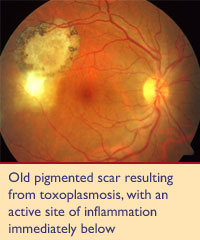






|
||
Other Eye Diseases |
||
Ocular ToxoplasmosisToxoplasmosis is one of the most common forms of eye problems, affecting almost one quarter of the population at one time or another. It is caused by a parasite acquired from a pet - usually a cat - or by eating rare or poorly cooked meat. The symptoms of this are similar to the flu, and many people would be totally unaware of having such a disease that could lead to serious eye problems. A small percentage of the cases of toxoplasmosis may develop into ocular toxoplasmosis. Toxoplasmosis is particularly worrisome in the case of pregnant women contracting the disease for the first time, when she has no immunologic protection for herself or the baby. There is particular concern if a woman contacts toxoplasmosis during the first trimester of pregnancy, as this can lead to a number of problems, including miscarriage or stillbirth and sometimes to liver, brain or eye damage for the baby. A baby's eye infection at birth may be readily healed. However, it will not be apparent until later in childhood, at a vision test, whether there is any scarring inside the eye. Typical scarring from a baby's eye infection involves the retina and the choroids, the layer of blood vessels that lies beneath the retina. The highest potential for damaged vision happens when the macula, the centre of the retina, has been scarred. Even though the infection may have been healed, some toxo organisms might well remain dormant in the form of small cysts. Flare-up, or reactivation, an occur years later. The symptoms include a gradual haziness, blurring of vision in one eye or acute multiplication of floaters. This may happen over a few days - or even weeks. If the site of inflammation is close to the centre of vision, this decrease in vision could be over a few hours. However, if there has already been a degree of scarring on the macula from an earlier toxo attack, the decrease in vision will be less noticeable. Similarly, if the damage is off to one side, the impact may be limited to some haze or floaters. Treatment for ocular toxoplasmosis will depend on the severity and location of the inflammation. Treatment may not be needed if the inflammation is mild - or indeed if the macula has already been scarred. If there is a perceived threat to the macula, oral medications will be prescribed. |
||